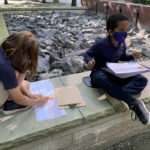We welcome Diploma Programme (DP) graduate turned IB teacher Eleni Vardaki, who graduated from the Anglo-American School of Moscow in 2004. Eleni offers her expertise on how students can reduce their stress and anxiety during the remote learning.
Eleni’s experience running her mentorship practice and research in the field have guided her understanding of stress and coping mechanisms.

The coronavirus: Impact on schools and students
The last few weeks have been an absolute whirlwind for everyone as the COVID-19 (Coronavirus) pandemic hit almost every country in the world. We went from thinking the coronavirus was a problem in a distant part of the world, to hearing that the first person in our country or neighborhood tested positive for COVID-19 overnight. We still don’t know when schools will re-open again or when we will return to our normal lives.
Imagine being a student. You’re told you’re not going to school anymore. Almost overnight, you’re now going to have to be more: responsible, organized and self-disciplined in your learning, all while not knowing the next time you’ll see your friends.
For students to be able to cope reactively and proactively to how quickly the situation is developing and how their day-to-day school lives, and the world is changing, they need to take their self-soothing and self-motivation skills up to the next level … fast.
Increased sources of stress for students
“The causes of stress may be the same but the way they manifest into a child’s behavior can differ from person to person.”
Here’s a list of the five biggest sources of stress I’ve come across in my mentoring work with middle school and high school students since the start of this global crisis.
I’ve noticed than when my mentee and I work together to process the emotional component of these sources of stress, they can start to think clearly again.
Students come to me when they’re feeling stuck in stress and overwhelmed because too many of these stressors have come all at once, creating a shock to their system, which keeps them stuck in a state of paralysis and overwhelms them. This can put students in a place where they don’t know what to prioritize and where to start.
If too many of these worry thoughts and frustrations are happening at the same time and the intensity of the worry or anxiety is above a certain threshold, this can leave a student feeling stuck in stress and overwhelmed to the point where they’re starting to fall behind.
It’s particularly difficult for students to adapt to e-learning because the inevitable trial-and-error nature of this first-time experience means that students need to step up their self-awareness and emotional self-regulation skills to cope with the quantity of changes in such a short space of time.
The biggest stressors
- Feeling stressed due to uncertainties:
- Not knowing how long it will be until they go back to school
- Not knowing how long it will be until they get to see their friends again, in person
- Not knowing if they, or someone they care about, has the coronavirus without showing any symptoms, yet
- Feeling stressed due to technology:
- Feeling frustrated every time the school’s technology crashes while trying to access the online material or live lessons
- Feeling frustrated with having to figure out how to get onto the new online learning systems
- Struggling to get online for all their live video lessons because of a bad internet connection
- Feeling stressed about school work or academic progress:
- Worrying about how their final diploma exam grade will be determined
- Feeling stressed trying to keep up with all of the work being set on the e-learning platform
- Finding it hard to focus and motivate themselves to get their assignments and school work done
- Feeling stressed due to the increased conflict at home:
- Hearing their parents arguing more than usual
- Arguing with their parents more than usual
- Feeling stressed due to inner conflict:
- Feeling frustrated with themselves for procrastinating, again.
- Feeling anxious about how behind they’ve fallen with their school work, but at the same time not feeling ready to face it all
- Alternating between feeling fine and feeling panic, anxiety or frustration
What can we do to help students cope?
I believe it’s vital that schools and parents work together in partnership to teach kids on gentle self-soothing and stress management techniques that students of all ages can use to cope with the chronically high levels of stress they are currently experiencing and/or are about to experience in the coming weeks and months ahead.
Any technique that will help students ground themselves into the present moment, whether it’s a simple breathing exercise or a more advanced technique, like the Emotional Freedom Technique, will help students get out of the fight-flight-freeze response that gets triggered when they are under stress.
I’ve noticed that most of the students I mentor for stress relief who struggle with procrastination tend to have a, ‘flight’, or, ‘freeze’, response to stress. What I mean by that is: Instead of facing the stress, they avoid it and don’t want to face it (flight response) or they want to face it but feel too paralyzed to be able to face the e-learning environment and tasks their teachers set (freeze response).
“I believe it’s vital that schools and parents work together in partnership to teach kids on gentle self-soothing and stress management techniques that students of all ages can use to cope”
To a parent, this could look like laziness, like their child is not doing much, spending too much time on social media or talking with their friends. But for a child whose stress response pattern typically leans towards the flight or freeze response, they may be experiencing a tremendous amount of stress inside. Students being tied to their phone is a negative coping mechanism for self-soothing and relaxation because they don’t know a healthier way to cope with the stress and feelings of being overwhelmed.
With other kids, the increased stress could be a lot more visible. You might see your child having more and more emotional outbursts or breakdowns that leave their parents worried about their well-being and feeling unsure about what they can do to really help. Yet other kids may get more irritable and argumentative under stress, feeling defensive and angry anytime their parents try to talk to them.
There are also kids who look like they’re coping fine on the outside, but they are, ‘fighting’, to the point where they’re overdoing it and overworking themselves; staying up late at night and sacrificing sleep and their need for regular breaks and rest in order to keep up with all the school work. The causes of stress may be the same but the way they manifest into a child’s behavior can differ from person to person.
What’s important is that students learn healthier ways to manage their stress, so that they can have access to the part of their brain that’s responsible for higher order thinking and decision-making: the prefrontal cortex. If a student is stuck in stress and overwhelmed, they will be unable to access this decision-making part of their brain that helps them make better choices for how to manage their time. To decide on what the new routines will be that they need to put in place to effectively support themselves in their new learning and living environment, they need to reduce their stress to be able to make wise choices
Simple meditation techniques like square breathing (e.g. Breath in for a count of 8, hold for a count of 8 and breath out for a count of 8. Repeat another 6-10 times) can help you move out of the amygdala, or emotional, part of your brain and into a state of mind where you can make decisions. But what I’ve found in my mentoring work is that breath work meditations don’t work for everyone.
Some kids need a more active, somatic approach to meditation in times of stress. For students that have a lot of energy and are used to moving their body, the lock-down and quarantine restrictions can almost feel suffocating and unbearable. They need to move―they may even have had a very active sports or dance life before the lockdown, and they may now be finding it hard to sit still in front of a computer or at their desk for so many more hours than they used to.
What I love about the Emotional Freedom Technique (also known as EFT or tapping) is that it gives teenagers and young adults an outlet to help them release all of their pent-up energy, anxiety, worry and frustration in a way that is gentle and feels grounded again. Tapping is a self-soothing form of somatic meditation that’s been proven to reduce cortisol and adrenaline, which are stress hormones in your body. From all of the stress management techniques I’ve taught my mentees over the past 4 years, I’ve found tapping to be the most effective technique for helping students overcome stress. I was so impressed with the excellent results I was seeing from teaching my mentees this technique that I decided to specialise in this area.
I’m now an accredited EFT practitioner and I continue to be in awe of how helpful this little-known form of somatic meditation can be for helping students who are stuck in stress. However, the more I read about the emerging science of neuroplasticity and energy psychology, the more I understand why tapping meditations work so well for stress and feelings of being overwhelmed.
If you’d like to learn more about these topics, the three books I would recommend as starting points for the science behind tapping and to learn how to do it yourself are:
- Patricia Carrington (2008) Try It On Everything: Discover the Power of EFT
- Bruce Lipton (2015) The Biology of Belief
- Nick Ortner (2018) The Tapping Solution for Children Parents, and Teenagers: How to Let Go of Excessive Stress, Anxiety and Worry and Raise Happy, Healthy, Resilient Families
To find out more about working with me or teaching your students this self-soothing type of somatic meditation, you can go to my official website: https://elenivardaki.com/

Eleni Vardaki is part of the minority of DP teachers who have experienced the programme from the perspective of a student. She completed her IB diploma at the Anglo-American School of Moscow in 2004. In 2010, she received her Master’s in Education from the University of Cambridge, and since then she has worked as a classroom teacher, workshop leader, middle manager and virtual youth mentor. She now splits her time between her teaching job in an IB World School and her online services as a Youth Mentor for Stress Relief. For more information about her work, visit elenivardaki.com.
To hear more from Diploma Programme (DP) graduates check out these IB programme stories. If you are an IB grad and want to share your story, write to us at alumni.relations@ibo.org. We appreciate your support in sharing IB stories and invite you to connect with us on LinkedIn, Twitter and now Instagram!
If you enjoyed this story, consider reading more below:



